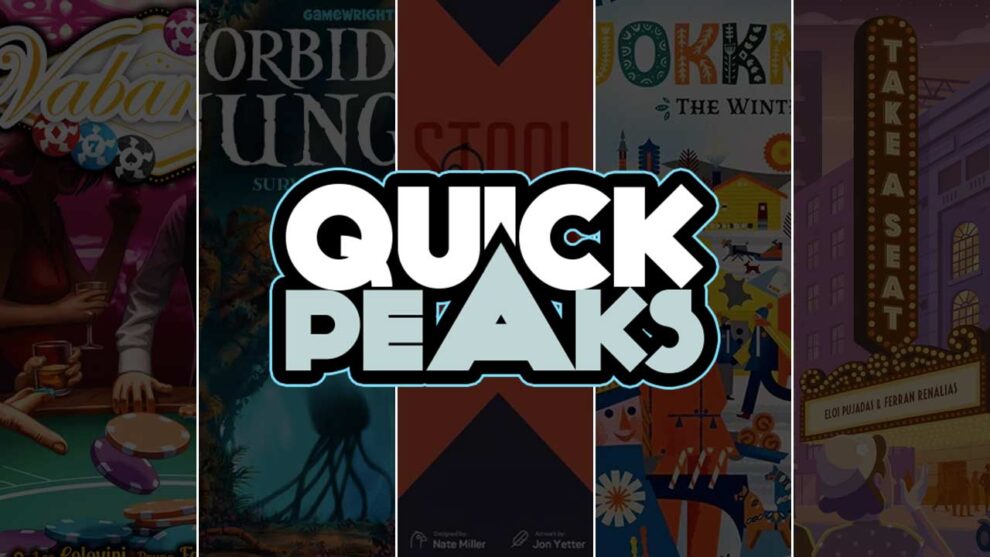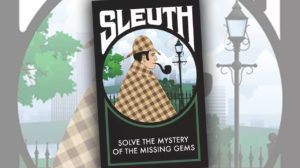Vabanque – Justin Bell
Tom Vasel of The Dice Tower claimed that Vabanque was his favorite betting/bluffing/gambling game of all time, so I picked up a copy. It sat on my very small shelf of shame for months; thanks to a six-player game night recently, I got Vabanque to the table.
Based on an 18th-century gambling game known as “Faro”, Vabanque plays 3-6 players in about an hour. Over the course of four rounds, players have to add poker chips to various small tables scattered around the play area, adding value to each station along the way. Then, the hook—each player has three action cards that can be played at the same or multiple tables, messing with everyone’s heads during the round. One card is a straight bluff; one is a Raise card, multiplying the value at that table by 1X (meaning that a table with $20K and a Raise card is now worth $40K instead of just $20K). The final card is a Trap card—a player with a Trap card at a table with other player tokens gets paid that table’s value for each opposing token there.
Those Trap cards, the table talk, the mind games, and the betting system were all fantastic. I don’t think this game would be nearly as good with three or four players. But at six players, the drama was great. It was even better when the player who won ZERO dollars in the first two rounds pulled out a victory with a series of masterful moves in the back half of the game. Vabanque was co-designed by Bruno Faidutti, the man who gave us Citadels and Incan Gold; like those other games, deception is the name of the game here in Vabanque and I’m keeping this one in the collection!
Ease of entry?:
★★★★☆ – The odd bump or two
Would I play it again?:
★★★★★ – Will definitely play it again
Read more articles from Justin Bell.
Forbidden Jungle – Andy Matthews
Back in the 2010 Matt Leacock released what would go on to become a favorite of many gamers: Forbidden Island. A lightweight, Indiana Jones inspired cooperative game which pitted players against a slowly collapsing island. Rescue the 4 artifacts, make your way to the helicopter, and get out before the whole thing sinks into the sea. It went on to spawn Forbidden Desert (quite the challenge) , Forbidden Skies (forgettable), and now Forbidden Jungle.
The newest entry into the series drops players into a jungle of nightmares. Eggs the size of your head, creepy crawler hatchlings, and the massive spiders that will sting and block your path with webs. I’m happy to say that Forbidden Jungle reminds me of what made the series so good to begin with. Great components, clever gameplay, and it’s not a guaranteed victory, and it makes you feel like you can win at every step…until the wheels fall off that is.
Having actual opponents in the game brings a nice challenge, and the fact that each side of a tile has a color on it, means that even when you’re setting the “board” up in the same pattern, it’s going to act differently. Forbidden Jungle would make a great addition to your game table. Give it a shot.
Ease of entry?:
★★★★★ – No sweat
Would I play it again?:
★★★★★ – Will definitely play it again
Read more articles from Andy Matthews.
Stool Pigeon – Will Hare
Among the chaos of PAX Unplugged, I found myself drawn to trying out quick hit filler games whenever I had five minutes to sit down and catch my breath. Stool Pigeon wound up being the surprise hit for my little gaggle of gamers. The concept is fairly simple: four cards are facedown in front of each player, and everyone starts by knowing only what two of them are. Each turn, you will draw a card from the deck and look at it, then decide which of your four face-down cards to discard in order to make room for it. The goal is to get the lowest possible value in your tableau, because at any point, a player can pass their turn and call for the endgame, meaning everyone else only gets one additional turn to try to optimize their cards.
The neat wrinkle that makes this beyond a simple memorization game, however, comes from the on-discard effects that many cards have. Some cards let you swap any two cards in the game, others let you remove a card entirely, and others let you peek at any card… either your own or another player’s. Keeping track of all this information while cards are being swapped and switched around is a recipe for disaster, and that’s half of the fun. If you’re fast on the draw, you can discard one of your cards from your hand if an opponent discards a card of the same value, but you’ve got to be quick, and you’ve got to be confident.
The game is kitschy with its “pigeon mafioso” aesthetic, because why not? Why shouldn’t pigeons put together a notorious crime syndicate? It plays in a brisk ten minutes or so, making it a perfect little filler game to pull out in between larger games or perhaps while waiting for dinner at a restaurant. Cute, quick, and funny.
Ease of entry?:
★★★★☆ – The odd bump or two
Would I play it again?:
★★★★☆ – Would like to play it again
Read more articles from Will Hare.
Jokkmokk: The Winter Market – Bob Pazehoski, Jr.
A massive game of leapfrog, mechanically not unlike Tokaido or Namiji, with a variety of spins on card collection à la Sushi Go or Sea Salt & Paper. This is the nutshell inhabited by the Swedish-set Jokkmokk: The Winter Market. The market board is bordered by cards aligned with spaces. Player meeples stand in line, one per space, forming a train that snakes at the beginning, ABCCBA or the like. The meeple in the back jumps to the front or beyond, landing on an available space and collecting the card.
Much like Sushi Go Party, there are a variety of menus or combinations of cards employed in each game. Some cards simply give points. Some contain different numbers of hot dogs along with point values, and the player with the most hot dogs only scores half the points. Others have teapots and grant a 10-point bonus for each set of three teapots. Obviously you have the opportunity to jump in and take a card that someone wants. Additionally, certain cards grant the power to distribute cards to other players, interrupting their lives with extra hot dogs.
The decks are divided into night and day cards, guaranteeing that the game ratchets up the intensity, and a Swede walks behind the meeples making sure no cards will remain for the next lap around the board should they be avoided by all. The deck is only ever so large, so the game cannot possibly take a long time. We learned and were finished in under a half hour. It’s a nice twist on the mechanics. The art is vibrant and charming. The components and cards are what you would expect. If you’re into the breezy and brief card-collecting experiences, Jokkmokk should probably be on your list to try out.
Ease of entry?:
★★★★★ – No sweat
Would I play it again?:
★★★★★ – Will definitely play it again
Read more articles from Bob Pazehoski, Jr.
Take a Seat – Andrew Lynch
Has the roll & write finally died out? It’s been a hot minute since I played one. Take a Seat is the first one I can remember hitting the table since spring of 2022, though that may not mean anything. Most roll & writes are not particularly memorable. That’s part of their appeal, that they can wash right off of your brain as soon as you’re done playing.
Take a Seat learnt some lessons from Cartographers, borrowing without committing theft. Players perform their turns simultaneously, placing tetrominos in a theater. The idea is to fill as many seats as possible, while fulfilling randomly assigned scoring requirements. While Cartographers got a lot of mileage out of the rotating scoring system, Take a Seat has the first scoring requirement score twice, which helps create a similar sense of focus. On top of that, Take a Seat has some player interaction, as you share tetromino selection boards with each of your neighbors, slowly changing the shapes as the game goes on.
There are some production issues. The manual could do with a little reorganizing, and the symbols corresponding to each color aren’t particularly clear. The colorblind among us will struggle with this one. Overall, Take a Seat gets the highest possible compliment I can give a roll & write: it exists, and I had a perfectly alright time.
Ease of entry?:
★★★★☆ – The odd bump or two
Would I play it again?:
★★☆☆☆ – Would play again but would rather play something else














Add Comment